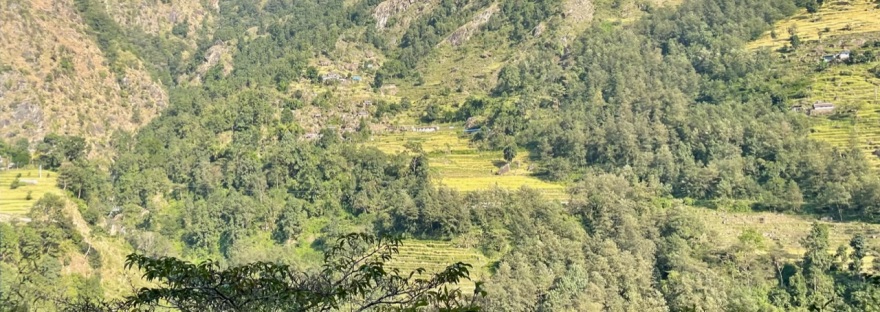by Dinesh Panday and Roshan Babu Ojha
Fertile soils are essential for sustaining plant growth and producing sustainable food systems. But around the world, they face unprecedented threats and as of today, approximately one third of the world’s soil is reported to be degraded. Restoring – as well as maintaining – soil fertility is therefore of utmost importance for building a resilient environment and producing sustainable food systems.
Although there are numerous common threats to soil fertility that have been identified around the world, soil fertility is also a dynamic issue that varies according to local conditions. In this blog we provide a regional perspective from Asia to identify the key issues affecting soil quality and the steps that can be taken to restore soil health.
Understanding soil fertility
Healthy, fertile soils are a prerequisite for sustaining plants and crops. By providing essential nutrients as well as necessary chemical, physical and biological characteristics, they create habitats that enable plant growth. However, key nutrients are not always available in soils. One of the reasons for this is that unsustainable soil management practices – such as intensive input farming systems and monoculture – are contributing to nutrient mining (the creation of a negative nutrient balance).
But soil fertility is not just an issue related to soil nutrients. It is also related to the soil’s ability to supply and exchange adequate amounts of soil moisture and air. A soil may have good nutrient supply, but if it is physically altered – perhaps it is waterlogged or compacted (constrained soil aeration) – or it has poor biological properties such as limited microbial activity, these available nutrients cannot be used and absorbed by plants and crops.

Geographic variations
According to the United Nations Food and Agriculture Organization (UNFAO) Intergovernmental Technical Panel on Soils, there are ten major soil threats globally – the most severe of which are soil erosion, soil organic carbon change, and nutrient imbalance. Climate change, too, is wreaking havoc upon soil fertility in many regions of the world.
However, soil fertility must be understood as a dynamic concept that changes according to local and regional conditions. While there is often a degree of overlap in the precise threats that soils face around the world – soil resources in Iran and Taiwan, for example, face almost exactly the same challenges – there can also be significant differences between countries. Take Bangladesh and its neighbour Nepal. While soil salinity is the most significant threat in Bangladesh, Nepal’s soils face other threats such as soil erosion, soil acidity and nutrient mining.
Many new soil issues are also arising at the national level. In India and Sri Lanka for instance, soils have experienced heavy metal contamination due to the use of fertilizers and agrochemicals. With the development of state-of-the-art technologies, new soil biodiversity threats (such as microbial habitat loss) are also being identified. Elsewhere, many developing countries have experienced worsened soil contamination in the wake of the COVID-19 pandemic because of personal protective equipment waste.
Observations from Asia
In our research across Asia, we have observed three main causes for declining soil fertility in farmland. These are soil erosion (prominent in most Asian countries), nutrient imbalance (in Nepal, Bangladesh and some parts of India and Pakistan), and soil carbon loss (in Nepal and the Indo Gangetic Plains). Rates of annual soil loss are particularly high in Nepal (about 25 t ha-1 yr-1) and even higher in Bhutan (29 t ha-1 yr-1).
Looking into this more closely, we know that a particularly critical threat to soil in many Asian countries is the issue of nitrogen fertilizer imbalances and soil carbon loss in agriculture. Farming practices in the region – specifically the use of crop residues for fuel and fodder instead of returning it to the soil – are also contributing to soil carbon loss.
Possible solutions
Two approaches are needed to improve soil fertility. The first requires identifying the local cause of soil degradation and implementing site specific nutrient management practices. In Nepal for example, a Digital Soil Map has been launched which provides the macro- and micronutrient status of farmers’ fields, as well as information regarding other physio-chemical soil properties such as pH levels, sand content and organic matter content. The Soil Health Card Scheme in India is a similar effort to note.
On top of this, regional cooperation is required to tackle wider issues. A good example is the Asian Soil Partnership under UNFAO’s Global Soil Partnership program, which enhances collaboration between government institutions to solve regional soil issues. We can look, for instance, at the issue of residue burning which is a major issue in India and some parts of Nepal. By raising awareness of the dangers of this practice, farmers are increasingly retaining residue in the field – although this still needs to be replicated more widely. Similarly, we recently recommended the use of a revised potassium nutrient dose in Nepal, where potassium has become a limiting nutrient. Farmers have subsequently started to adopt this fertilizer source, which previously had rarely been used.
We think that approaches such as these are critical. To put it simply, conserving soil is our responsibility and failure to do so threatens our future.
Drs Panday and Ojha are soil scientists and co-editors of the book, “The Soils of Nepal” (Springer Nature, 2021). Dr. Panday is a member of Young Scientists Group and Communications officer at YPARD Asia and Pacific region. Dr. Ojha is a member of Young and Early Career Scientist Working Group, IUSS.


